Anglican Church
 In the early days of St. Aidan’s, the services were held in the school chapel. The first lay reader, a teacher named Arthur Sharpe, officiated from 1900 and the first clergyman, Canon H.W. Facey, came to the Mission in 1910. The cornerstone for the church was laid on August 29, 1907 by Bishop Jones. On June 16, 1918, the church was officially opened by Rev. Augustus Bagley and assisted by Rev. Facey. Master builder of this structure was Edward Fitzgerald of Red Cliff, Bonavista Bay, and it was considered one of the finest wooden churches in the entire diocese.
In the early days of St. Aidan’s, the services were held in the school chapel. The first lay reader, a teacher named Arthur Sharpe, officiated from 1900 and the first clergyman, Canon H.W. Facey, came to the Mission in 1910. The cornerstone for the church was laid on August 29, 1907 by Bishop Jones. On June 16, 1918, the church was officially opened by Rev. Augustus Bagley and assisted by Rev. Facey. Master builder of this structure was Edward Fitzgerald of Red Cliff, Bonavista Bay, and it was considered one of the finest wooden churches in the entire diocese.
Over the years some major repairs and upkeep were done such as removing the original slate roof to replace with shingles, removal of the oil lamps for electrical lights and replacing the wood burning stove for an oil furnace. In the 1970’s, the original steeple was removed and replaced with a smaller one due to excessive maintenance costs. The final modification was the addition of a basement which was dug out under the building and converted into a hall for community functions.
The bell tower has been kept intact and each Sunday, you can still hear the original bell ringing calling the congregation to worship. St. Aidan’s celebrated its 100th anniversary in 2007 and the congregation still feel privileged to worship in such a fine structure.
Causeway Tragedy
 On New Year’s Day 1963, warm temperatures and heavy rain caused an increase in water levels and rushing ice on Southwest River which lead to the collapse of the Port Blandford causeway. Before residents could get to the scene and stop traffic, two vehicles fell into the swirling waters resulting in the deaths of two residents of Musgravetown and three residents of Port Blandford.
On New Year’s Day 1963, warm temperatures and heavy rain caused an increase in water levels and rushing ice on Southwest River which lead to the collapse of the Port Blandford causeway. Before residents could get to the scene and stop traffic, two vehicles fell into the swirling waters resulting in the deaths of two residents of Musgravetown and three residents of Port Blandford.
The bodies of Gordon Burden (46), Doreen Burden (17), and Alice Maude Garrett (53) were recovered on January 5. Funeral services were held at the Anglican Church in Port Blandford on January 6. The body of Harry Skiffington (20) washed ashore on March 23 and the body of Robert Skiffington (46) was found by causeway workers on March 26.
Work on the bridge started January 7 and quick repairs were necessary as this was the only road connecting St. John’s with Port aux Basques. Work crews reconstructed the bridge by working from both ends at the same time and it was officially opened on January 24, 1963.
The Department of Highways published a tender on March 14, 1963 for a reinforced concrete bridge to replace the wooden structure built in January. Premier Joey Smallwood announced on June 13, 1963 that all 1500 wooden bridges across Newfoundland would be replaced within the next eight to ten years.
Commercial Centre
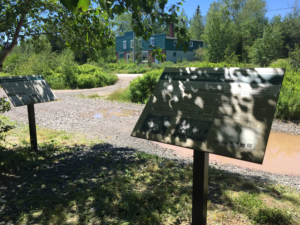 With the building of the railway and coastal steamer wharf in 1892, Port Blandford became a service centre as the S.S. Dundee shipped supplies, mail and passengers from the trains to the communities all around Bonavista Bay. In the first decade of the 1900’s, the community was home to a customs, postal and telegraph office, two hotels, four stores and a newspaper (The Telegrapher edited by William Ford Coaker who was the telegraph officer from 1903-1904). In 1909 and 1910, a small factory built in the community became one of the first efforts to commercially can mussels.
With the building of the railway and coastal steamer wharf in 1892, Port Blandford became a service centre as the S.S. Dundee shipped supplies, mail and passengers from the trains to the communities all around Bonavista Bay. In the first decade of the 1900’s, the community was home to a customs, postal and telegraph office, two hotels, four stores and a newspaper (The Telegrapher edited by William Ford Coaker who was the telegraph officer from 1903-1904). In 1909 and 1910, a small factory built in the community became one of the first efforts to commercially can mussels.
With the building of the Bonavista Branch line in 1913, the reliance of the coastal boat out of Port Blandford on the Bonavista Peninsula diminished, but the community remained a commercial centre for Clode Sound. As the only connection to the rest of the province via the railway, residents of communities like Charlottetown and Bunyan’s Cove travelled by cart paths and boats to Port Blandford to purchase their supplies in the community’s large general stores.
With the completion of the Trans-Canada Highway in 1965, a short linkage to the larger service centre of Clarenville was created. As a result, the majority of the retail businesses closed over the next several decades, leaving just a couple convenience stores in the community.
Constable William Moss
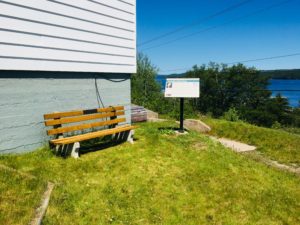 William Moss was born March 3, 1935. As a young man, he joined the Royal Newfoundland Constabulary (RNC) and became a Constable in St. John’s.
William Moss was born March 3, 1935. As a young man, he joined the Royal Newfoundland Constabulary (RNC) and became a Constable in St. John’s.
The Newfoundland Logger’s Strike began on December 31, 1958 when hundreds of loggers employed by the Anglo-Newfoundland Development Company (A.N.D. Co.) at Grand Falls refused to work until they saw an increase in wages, and better working and living conditions at the wood camps. The A.N.D. Company and the logger’s union, the International Woodworkers Association (IWA), did not come to any agreement and after six weeks on February 12, 1959, the provincial government, under Premier Joey Smallwood, passed a law in the legislature stripping the IWA of its legal bargaining rights.
By early March, additional officers of the Royal Canadian Mounted Police (RCMP) and the RNC, including Constable Moss, were stationed at Grand Falls to monitor the situation. On Tuesday, March 10, 1959, a contingent of officers was sent to the town of Badger to keep the peace. That evening, 66 RNC and RCMP officers were ordered to march through the community where approximately 250 IWA workers were gathered. The two sides clashed and before the incident was over, Constable Moss was on the ground after suffering a blow to the head from a piece of wood. Constable Moss was taken to hospital in Grand Falls and died from his injuries two days later on Thursday, March 12, 1959, becoming the first RNC officer to die in the line of duty. His body was returned to Port Blandford where he was buried.
Smallwood replaced the IWA with the government sponsored Newfoundland Brotherhood of Wood Workers. The loggers quickly signed a contract with the A.N.D. Co. and ended the strike. The Newfoundland government subsequently set up a Royal Commission into the logging industry and it was recommended that camps be supplied with electricity, piped water, hand basins, heating stoves, and proper food.
Fire Patrol
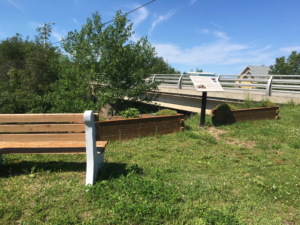 Port Blandford played a significant role in the history of Newfoundland fire patrol. Legislation was first enacted by the Newfoundland Government on June 15, 1905 to protect the forest resources from the ravages of wildfire. This was the Forest Fire Act. The railway had created a major problem and caused hundreds of fires annually, eventually resulting in burning almost all timberlands adjacent to its right-of-way.
Port Blandford played a significant role in the history of Newfoundland fire patrol. Legislation was first enacted by the Newfoundland Government on June 15, 1905 to protect the forest resources from the ravages of wildfire. This was the Forest Fire Act. The railway had created a major problem and caused hundreds of fires annually, eventually resulting in burning almost all timberlands adjacent to its right-of-way.
Very shortly after passage of the Act, a forest fire patrol was established by the government. Its staff consisted of four people; Thomas Howe, the Chief Ranger who was stationed at Port Blandford, and three assistants, who were located at Whitbourne, Robinson’s Station in the Codroy Valley and at Deer Lake. Patrolling during these early days was done on foot and equipment was limited to water pails, axes, and shovels.
In 1920 the first hand pumps and velocipedes (a three-wheeled hand propelled track vehicle) were introduced. This continued as standard equipment until the early 1930’s when the first powered pumps and powered rail cars (speeders) became part of the arsenal of equipment. The government authorized the establishment of the first fire lookout towers and construction was started in 1935. One of the first four towers was located at Mount Blandford, just to the southeast of Port Blandford.
Up until the closure of the railway in 1988, workmen from Port Blandford travelled on speeders that followed trains to watch out for fires and act as the initial attack crew.
Logging
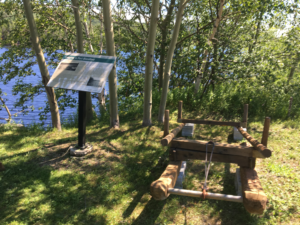 In the late 1800’s, even before the railway went through in 1892, there are accounts of settlers in Clode Sound who are logging the vast forests. Using basic tools like a bucksaw and axe, logging became the first big industry of the new community.
In the late 1800’s, even before the railway went through in 1892, there are accounts of settlers in Clode Sound who are logging the vast forests. Using basic tools like a bucksaw and axe, logging became the first big industry of the new community.
One of the greatest advantages of Port Blandford was the three rivers (Northwest, Salmon and Southwest) and large brook (Middle Brook) that flowed into the sheltered bay. These waterways allowed for cutters to venture deep into the country and harvest the abundance inland timber. “Driving” the logs out the rivers by floating them on the rapid moving water, “booms” were set up at the mouths of the rivers to catch the timber and prevent it from floating away. Once the logs were at the salt water, they would be moved to the closest sawmills to be run out into lumber.
Other methods of moving timber out of the woods included horse and sleigh and dog sleds during the winter. A common device used was a “go-devil”, which was a type of single bunk sleigh that was towed behind a horse for short distances, steep hills and difficult terrain. The term “go-devil” was used as when you started to go downhill, it would “go like the devil.”
As years passed, better equipment made harvesting easier with the introduction of tractors, power saws and harvesters, but over time, the demand in the logging industry declined and most operations were either sold or shut down.
Railway
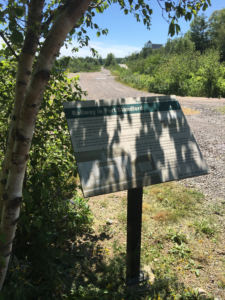 In 1892, the Newfoundland Railway passed through Clode Sound. Being the headwaters of Bonavista Bay, it was an ideal location to build a coastal boat terminal and railway station with a customs, postal and telegraph office.
In 1892, the Newfoundland Railway passed through Clode Sound. Being the headwaters of Bonavista Bay, it was an ideal location to build a coastal boat terminal and railway station with a customs, postal and telegraph office.
The railway benefitted the new community in numerous ways. As the railhead for Bonavista Bay, new businesses opened as Port Blandford became a commercial centre. Employment opportunities in the railway provided jobs to local families, and unlike most coastal communities, Port Blandford had a direct link to St. John’s and other centres via the train.
In 1949, Newfoundland joined Canada and under the Terms of Union, the Newfoundland Railway was transferred to the federal Crown corporation, Canadian National Railways (CNR). Although the rail system’s passenger and cargo services started declining once the Trans Canada Highway was built across the island in 1965, the railway continued to be a major employer for many residents of Port Blandford.
On September 3, 1978, a fire broke out at the railway station and the building was lost to the community. With the decline in the industry, the station was not replaced, and on September 1, 1988, almost 10 years to the day from when the station was lost, the railway in Newfoundland was officially abandoned.
In the 1990’s, the railbed was turned into a multi-use trail called the T’Railway Provincial Park, and today, many of the tourism operators in Port Blandford benefit from the recreational users. Over 100 years after being first installed through the community, the railbed is still providing opportunities.
Sawmilling
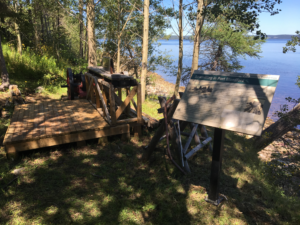 Some of the earliest accounts of Clode Sound in the 1870’s describe the area as “a great quantity of good undisturbed land just awaiting the axe and plough of the settler.”
Some of the earliest accounts of Clode Sound in the 1870’s describe the area as “a great quantity of good undisturbed land just awaiting the axe and plough of the settler.”
With the establishment of the railway through the area and the building of the coastal boat terminal in 1892, opportunities for new markets in the lumber industry emerged for the community. Between 1890 and 1900, over 3.5 million feet of lumber passed through Port Blandford bound for St. John’s and American ports.
In 1901, Daniel Pelley established a sawmill on Southwest River, and by 1911, the Stares family had built a mill near the steamer wharf. The Stares mill was reported to have six different kinds of saws, putting out matched board, shingles, heading and staves. It was also reported in the early 1900’s that it was estimated that the men of Port Blandford would cut 35,000 bundles of hoops during a winter.
Over the next several decades, Pelley’s became the largest producer in the area, and they purchased rough lumber and squares from local operations which were re-sawed, planed and shipped to market. In the early 1960’s, the Pelley’s mill caught fire and the loss led to a further decline in the industry. By the late 1960’s, the majority of the larger commercial operations started to close and several of the smaller operations focused on selling to local distributors.
By the 1980’s only a handful of mills remained, and today, a small number of them still exist for personal use.
Shipbuilding
 With the growth on the tip of the Bonavista Peninsula in the late 1800’s, people from the fishing communities started moving further into the head of Bonavista Bay for the forest resources. In addition to logging and sawmilling, shipbuilding played a role during the early years of development in Port Blandford. With the abundance of timber in the lush forests, several shipbuilding operations were located in various parts of Clode Sound to add to the growing schooner fleets around Newfoundland. In 1901, Daniel Pelley established a sawmill on Southwest River in Port Blandford, and part of the enterprise was a shipyard.
With the growth on the tip of the Bonavista Peninsula in the late 1800’s, people from the fishing communities started moving further into the head of Bonavista Bay for the forest resources. In addition to logging and sawmilling, shipbuilding played a role during the early years of development in Port Blandford. With the abundance of timber in the lush forests, several shipbuilding operations were located in various parts of Clode Sound to add to the growing schooner fleets around Newfoundland. In 1901, Daniel Pelley established a sawmill on Southwest River in Port Blandford, and part of the enterprise was a shipyard.
During the years of World War I and shortly thereafter, shipbuilding in Clode Sound reached its height. Steer Brothers Limited, a general trade business located in St. John’s, had businessman Daniel Pelley build five three-masted schooners in Port Blandford at that time. Averaging approximately 350 tons each, these vessels were built for the foreign fishing trade, carrying dried cod to Europe and the West Indies.
With the advance of new shipbuilding technologies and materials, wooden schooners soon became less in demand and the shipyards throughout Clode Sound shut down. For many decades after, local residents still continued to use local timbers to build small fishing craft to be used in the bay such as motor boats, punts and dories.
Speeder
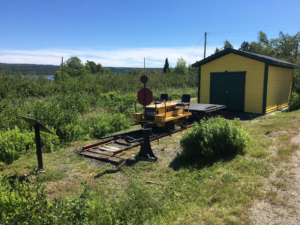 Many residents in Port Blandford were familiar with seeing the speeders going along the rails through the community, and several got to ride them when they worked for the railway.
Many residents in Port Blandford were familiar with seeing the speeders going along the rails through the community, and several got to ride them when they worked for the railway.
The railway speeder was a small transport vehicle that ran along the rails and was used for a variety of tasks. Although slow compared to a train, it was called a speeder because it was faster than the earlier human-powered vehicles such as hand pumps and velocipedes (a three-wheeled hand propelled track vehicle). Larger speeders were used by work crews to transport workers, tools and materials to work sites to complete maintenance on the railway and smaller ones were used by track inspectors and the fire patrol.
The fire patrol speeders were usually two-person vehicles that followed the trains to watch for sparks from the friction between the train’s wheels and the track, especially during braking. Over the years, several residents of Port Blandford worked on the fire patrol speeders and there was a speeder shed located in the community.
The most common type of fire patrol speeders used between the 1950’s up to the railway’s closure in 1988 was made by Fairmont Railway Motors. The light-weight vehicle had handles installed underneath to lift it off of the tracks and the simple design made it easy to repair. Speeders could also tow small utility trailers that carried materials and tools as well as fire-fighting equipment for the fire patrol.
Steamer Wharf
 When the railway went through in 1892, a steamer wharf was constructed and the community became the railhead and coastal boat terminal for Bonavista Bay.
When the railway went through in 1892, a steamer wharf was constructed and the community became the railhead and coastal boat terminal for Bonavista Bay.
The 439-ton Dundee was built by A. & J. Inglis at Glasgow, Scotland in 1900 and registered in Newfoundland in the same year. The S.S. Dundee was the fourth ship in the Reid Newfoundland Company’s Alphabet Fleet, a group of coastal boats that serviced Newfoundland and Labrador during the early 1900’s. It carried mail and passengers around Bonavista Bay and to points north from its home port in Clode Sound, later renamed Port Blandford after her first master, Captain Darius Blandford.
Port Blandford’s steamer wharf was equipped with rails which allowed trains to load and unload directly onto boats. After the death of Captain Blandford in 1917, Dundee was mastered by Captain George Blackmore until Christmas Day 1919, when it went aground in Notre Dame Bay. The passengers and crew were stranded on the ship for two days because heavy seas and slob ice made rescue impossible. On the second day, when the ship began to take on water, the S.S. Clyde was able to reach the floundering Dundee and remove the passengers and crew before the ship sank.
With the building of the Bonavista Branch Line the coastal boat’s importance diminished, and the steamer wharf was eventually removed in the 1950’s.
United Church
 It appears that a Methodist congregation was established at Clode Sound by the early 1890’s, The Evening Telegram of July 10, 1894 carried a story of “Reverend W.H. Dotchon (Methodist) left St. John’s for his station at Clode Sound”. At this time the congregation was part of the Musgravetown mission.
It appears that a Methodist congregation was established at Clode Sound by the early 1890’s, The Evening Telegram of July 10, 1894 carried a story of “Reverend W.H. Dotchon (Methodist) left St. John’s for his station at Clode Sound”. At this time the congregation was part of the Musgravetown mission.
Just after the turn of the century, the congregation became part of the newly formed Port Blandford Methodist Circuit, along with Bunyan’s Cove, Charlottetown, Gambo and Benton. By 1905 Gambo and Benton were removed with Thorburn Lake and Terra Nova being added. A Church was constructed between 1905 and 1908, and served the congregation until the opening of the current building, which is the Alton United in 1978. It is believed that a combined chapel school served the congregation until 1908.
At the time of the union of the churches to form the United Church of Canada in 1925, Port Blandford was still head of the mission and administering to twenty-five families. Port Blandford, at this time, had a church and a one room school. The school expanded to a two story, two room school and was replaced by the construction of a three room school in 1953. The school was managed by the Minister and volunteers from the congregation until 1966 when it became part of an integrated board operated by the province. In the late 1970’s up to 1987, the building was used as a middle school with elementary students going to the former Anglican school and high school students to Clarenville.
